
Chives, scientific name Allium schoenoprasum, is a species of flowering plant in the family Amaryllidaceae that produces edible leaves and flowers. Their close relatives include the common onions, garlic, shallot, leek, scallion, and Chinese onion.

Nepenthes alata is a tropical pitcher plant endemic to the Philippines. Like all pitcher plants, it is carnivorous and uses its nectar to attract insects that drown in the pitcher and are digested by the plant. It is highly polymorphic, and its taxonomy continues to be subject to revisions.
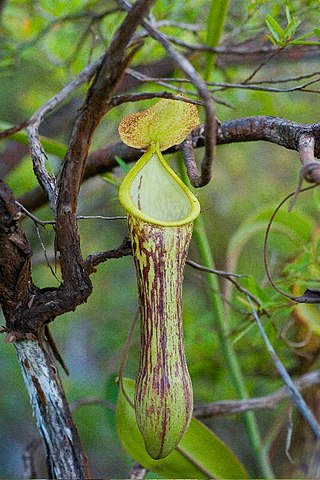
Nepenthes mindanaoensis is a tropical pitcher plant native to the Philippine islands of Mindanao and Dinagat.

Nepenthes eustachya is a tropical pitcher plant endemic to Sumatra, where it grows from sea level to an elevation of 1600 m. The specific epithet eustachya, formed from the Greek words eu (true) and stachys (spike), refers to the racemose structure of the inflorescence.

Ulmus alata, the winged elm or wahoo, is a small- to medium-sized deciduous tree endemic to the woodlands of the southeastern and south-central United States. The species is tolerant of a wide range of soils, and of ponding, but is the least shade-tolerant of the North American elms. Its growth rate is often very slow, the trunk increasing in diameter by less than 5 mm per year. The tree is occasionally considered a nuisance as it readily invades old fields, forest clearings, and rangelands, proving particularly difficult to eradicate with herbicides.

Euonymus alatus, known variously as winged spindle, winged euonymus, or burning bush, is a species of flowering plant in the family Celastraceae, native to central and northern China, Japan, and Korea.

Nepenthes graciliflora is a tropical pitcher plant endemic to the Philippines. Long considered a synonym of N. alata, it was restored as a separate species in 2013 by Martin Cheek and Matthew Jebb. It has been recorded from the islands of Bohol, Leyte, Luzon, Mindanao, Mindoro, Panay, Samar, and Sibuyan, and following the redelimitation of N. alata is the most widespread Nepenthes species of the Philippines. It is known from mossy, submontane forest, generally at 800–1,280 metres (3,000–4,000 ft) altitude, though the type specimen from Sibuyan was collected at only 300 m (1,000 ft).
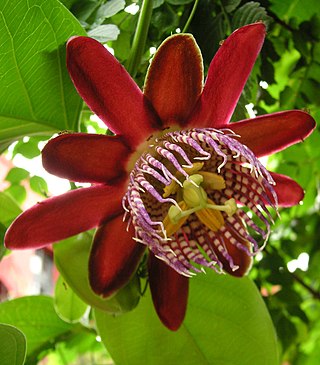
Passiflora alata, the winged-stem passion flower, is a species of flowering plant. It is an evergreen vine, growing to 6 m (20 ft) or more, which bears an edible type of passion fruit. It is native to the Amazon, from Peru to eastern Brazil.
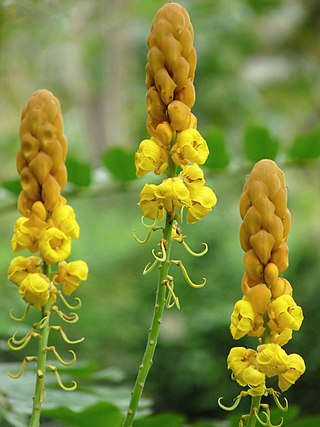
Senna alata is an important medicinal tree, as well as an ornamental flowering plant in the subfamily Caesalpinioideae. It also known as emperor's candlesticks, candle bush, candelabra bush, Christmas candles, empress candle plant, ringworm shrub, or candletree. A remarkable species of Senna, it was sometimes separated in its own genus, Herpetica.

Hyssopus officinalis or hyssop is a shrub in the Lamiaceae or mint family native to Southern Europe, the Middle East, and the region surrounding the Caspian Sea. Due to its purported properties as an antiseptic, cough reliever, and expectorant, it has been used in traditional herbal medicine.

Canscora is a genus 9 to 30 species of plants in the family Gentianaceae. Canscora is native to Africa, Asia and Australia. Some species are used medicinally.

Daviesia alata is a species of flowering plant in the family Fabaceae and is endemic to south-eastern New South Wales. It is a prostrate to low-lying shrub with winged branchlets that are triangular in cross-section, phyllodes reduced to scales, and orange, red, yellow and maroon flowers.

Dillenia alata, commonly known as red beech, golden guinea flower or golden guinea tree, is a tree in the Dilleniaceae family, found in tropical forests of the Moluccas, New Guinea, and northern Australia.
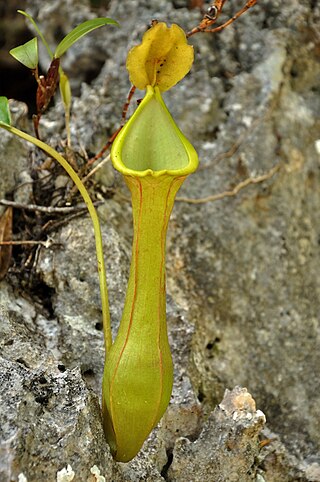
Nepenthes viridis is a tropical pitcher plant endemic to the Philippines. It is known only from coastal areas at low altitude and has been recorded from Dinagat, Samar, and a number of surrounding islets. It is closely allied to the N. alata group of species.

Peperomia alata, commonly known as the winged peperomia, is a species of plant in the genus Peperomia of the family Piperaceae. Its native range covers most of tropical and subtropical America, from southern North America through West Indies and Central America to South America. It can also be found in Florida, although there it is apparently rare, known for certain only from swamps in Collier County.

Spermacoce alata, the winged false buttonweed, is a species of plant in the Rubiaceae. It is widespread across the warmer parts of the Western Hemisphere and naturalized in many other parts of the world.
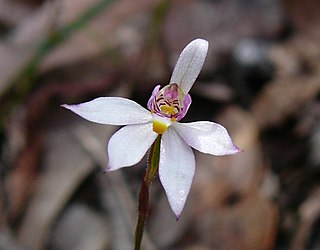
Caladenia alata, commonly known as the fairy orchid, is a plant in the orchid family Orchidaceae and is found in south-eastern Australia and New Zealand. It is a ground orchid with small, usually short-lived flowers, which have relatively stiffly held petals and sepals and reddish-purple bars on the labellum.

Boronia alata, also known as winged boronia, is a flowering shrub. It is an endemic species of Southwest Australia which has been introduced elsewhere as a cultivated plant.

Dampiera alata is a plant in the family Goodeniaceae, native to Western Australia.
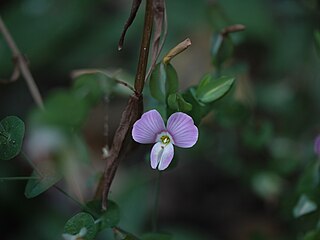
Canscora perfoliata, the pierced leaf canscora, is a herbaceous species of plant in the family Gentianaceae. It is endemic to the Western Ghats.




















